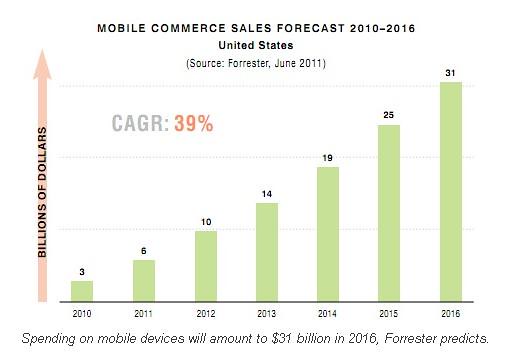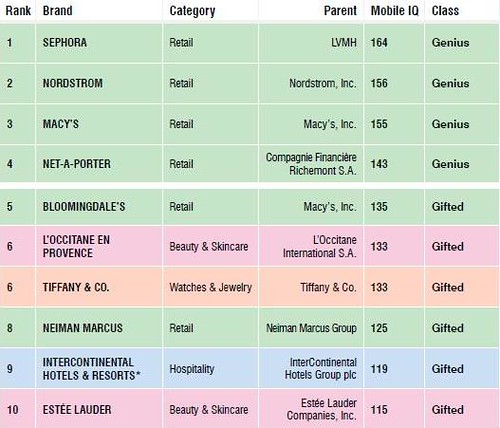In order to stay ahead of the others, ones must be alert and sensitive towards the changes in the market. Just like mobile phone, it is gradually replacing the ways we used to have last time. Do you actually notice that?
A recent report has revealed that the majority of premium brands are failing to keep up-to-date with the opportunities presented by mobile marketing.
The latest L2 Prestige Mobile IQ report suggests that use of effective mobile marketing practices is currently surprisingly low amongst top brands.
The report looked at mobile applications, mobile sites, mobile marketing (including SMS) and overall innovation and integration, ranking brands included in the study on their Mobile IQ score.
L2 argues that over the next few years, the businesses which will thrive are those willing to engage with mobile marketing techniques. Brands need to develop and optimize powerful mobile commerce sites which are accessible from a range of devices.
According to Forrester’s report in 2011, m-commerce sales are set to quintuple over the next five years, resulting in $31 billion worth of sales by 2016.
However, despite this forecast, a shocking 16% of the brands in the L2 report are yet to produce any kind of mobile app or website. In fact, almost half of the brands studied were ranked as ‘feeble’, meaning that their investment in mobile to date is little if any.
The brands at the top are offering engaging mobile apps, fully optimized m-commerce sites and flashes of creative genius.
These brands have managed to create some really effective mobile offerings which are often fully integrated into their rest of their offline marketing campaigns.
And those languishing at the bottom:
How are these brands letting themselves down with mobile?
The main reason these brands appear to be lagging behind is because they fail to utilise the unique platforms that m-commerce, iPhone and iPad apps offer.
1. Failures in M-commerce
Those languishing at the bottom of the list are there because they don’t capture the quality of their websites in their mobile experience. Generally, across every category measured, mobile sites consistently failed to replicate the features found on their main sites such as video and product search. Another significant issue they face is that they are directly hindering m-commerce by hosting websites in Adobe flash – which iOS does not support.
2. User experience problems on the iPhone
As the report suggests, the majority of the 70% of brands which have iPhone apps appear to consistently fail to make sure that the user experience is really excellent. Less than a third of these apps use the iPhone’s GPS software, 17% of apps utilise the notification system and even fewer use the phone’s camera and gyroscope capabilities.
L2 quotes ABI Research which reports that the iTunes Store ranking algorithm will begin taking into account qualitative information such as user reviews and frequency of usage. As such, there is little point having a promotional app with little functionality in order to simply maintain appearances. Brands need to invest in mobile apps which are valuable to the consumer and which garner great customer feedback.
What’s next?
- Brands need to invest in m-commerce now to take advantage of the increase in mobile usage.
- They need to create a seamless customer experience across a number of devices.
- Mobile apps need to provide real value and utilise the unique functionality of mobile devices.
By 2015, it is predicted that more users will access the Internet wirelessly via a mobile device than from a wired Ethernet connection. As consumers move their purchasing power from computer to mobile, brands cannot afford to be prudish about innovation in mobile marketing.ovation in mobile marketing.
Source: By Katie Glass on 19th January 2012.

Web SMS, 1-way Messaging, 2-way Messaging, SIM Hosting, Email-to-SMS, Developer (HTTP API & SMPP), White Label Reseller Program, HRL Lookup, Long Code Service, Non-premium Short Code, Industry Based Solutions etc. To know more about our products & services, visit our official websites: www.moceansms.com | www.bulksms.com.my | www.mocean.com.my
Category
- Africa (5)
- América Latína (4)
- Argentina (3)
- Asia Pacific (12)
- Australia (6)
- Azerbaijan (1)
- Bolivia (1)
- Brazil (1)
- Canada (1)
- Chile (4)
- China (6)
- Colombia (1)
- Ecuador (1)
- Europe (4)
- General (111)
- Ghana (1)
- Hong Kong (1)
- India (1)
- Indonesia (16)
- Ireland (1)
- Israel (1)
- Kenya (1)
- Malaysia (1)
- México (2)
- Middle East (1)
- Nepal (1)
- New Zealand (1)
- Nigeria (4)
- Pakistan (7)
- Paraguay (1)
- Perú (2)
- Philippines (4)
- Singapore (3)
- Slovakia (1)
- South Africa (3)
- Tanzania (3)
- Thailand (1)
- UAE (1)
- UK (8)
- Ukraine (1)
- Uruguay (1)
- US (6)
- Venezuela (1)
- Zimbabwe (1)
Subscribe to:
Post Comments (Atom)



No comments:
Post a Comment